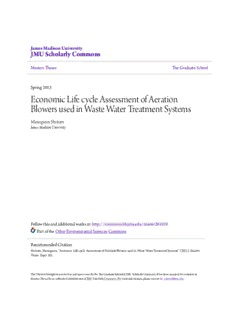
Economic Life cycle Assessment of Aeration Blowers used in Waste Water Treatment Systems PDF
Preview Economic Life cycle Assessment of Aeration Blowers used in Waste Water Treatment Systems
James Madison University JMU Scholarly Commons Masters Theses The Graduate School Spring 2013 Economic life cycle assessment of aeration blowers used in waste water treatment systems Manogaran Shriram James Madison University Follow this and additional works at:https://commons.lib.jmu.edu/master201019 Part of theOther Environmental Sciences Commons Recommended Citation Shriram, Manogaran, "Economic life cycle assessment of aeration blowers used in waste water treatment systems" (2013).Masters Theses. 265. https://commons.lib.jmu.edu/master201019/265 This Thesis is brought to you for free and open access by the The Graduate School at JMU Scholarly Commons. It has been accepted for inclusion in Masters Theses by an authorized administrator of JMU Scholarly Commons. For more information, please [email protected]. ECONOMIC LIFE CYCLE ASSESSMENT OF AERATION BLOWERS USED IN WASTE WATER TREATMENT SYSTEMS By Shriram Manogaran Master of Science in Sustainable Environmental Resource Management / Master of Science in Integrated Science & Technology UNIVERSITY OF MALTA/ JAMES MADISON UNIVERSITY 2013 i ECONOMIC LIFE CYCLE ASSESSMENT OF AERATION BLOWERS USED IN WASTE WATER TREATMENT SYSTEMS A dissertation presented in part fulfillment of the requirements for the Degree of Master of Science in Sustainable Environmental Resource Management/ Master of Science in Integrated Science and Technology. By Shriram Manogaran May 2013 Dissertation Committee Members Dr. Thomas R Benzing Dr. Steven Frysinger Dr. Robert Ghirlando University of Malta – James Madison University ii TO MY DAD, A. MANOGARAN “A man's desire for a son is usually nothing but the wish to duplicate himself in order that such a remarkable pattern may not be lost to the world.” HELEN ROWLAND iii iv Acknowledgement I would like to express my sincere gratefulness towards my thesis adviser- Professor Dr. Thomas R Benzing, James Madison University and to my dissertation committee co-chairs- Professor Dr. Steven Frysinger, James Madison University and Dr. Robert Ghirlando, University of Malta, for their patience, support and guidance throughout the course of this research. The work would not have been possible and satisfactory without their constant feedback and challenging discussions during each stage. It would have been extremely difficult if not impossible to pursue this study without the support and cooperation of the Stuarts Draft Waste Water Treatment Plant authorities. I am thankful to I would like to thank Dr. Maria Papadakis on helping I would like to thank Spencer Adams from the University Writing Center, James Madison University who helped me improve my quality of writing throughout this study. Lastly, I would like to express my gratitude to my family and loved-ones, for inspiring me to do better each day. The last couple of years would have been extremely difficult to survive without their love and support. Finally I big thank you and hugs to my Dad, Manogaran, who stood beside me all the time and helped me complete my Masters. v Table of Contents Table of figures Table of tables List of Acronyms 1. Introduction 1 1.1 Background 2 1.2 Rationale 3 1.3 Thesis Statement 4 1.4 Scope of Study 5 1.5 Methodology 5 1.5.1 Life-cycle Energy and Impact Assessment (LCEIA) 5 1.5.2 LCEIA Modeling and Key Parameters for Assessment 7 2. Literature Overview 9 3. Operation of Waste Water Treatment Plant 12 3.1 Introduction 12 3.2 Need for Water treatment 12 3.3 Oxygen Transfer 12 3.4 Process overview 13 3.4.1 Sludge Treatment 14 3.4.1.1 Anaerobic digestion 14 3.4.1.2 Aerobic digestion 15 3.4.1.3 Anoxic Digestion 16 3.4.2 Biological and chemical oxygen demand 16 3.5 Purpose of Aeration 17 3.5.1 Activated sludge 17 3.5.2 Activated Sludge Systems 18 3.5.3 Activated Sludge Process Operation 19 3.5.4 Purpose of Activated Sludge Treatment Process 21 3.6 Aeration Blowers 22 vi 3.7 Variable Oxygen demand 27 3.7.1 Oxygen demand 27 3.7.2 Chemical processes which occur in biological waste treatment 28 3.8 Oxidation in ponds 29 3.9 Process control in an Activated Sludge system 31 3.10 Diffusers 33 4. Stuarts Draft’s Waste Water Treatment Facilities 35 4.1 Background 35 4.2 Site plan and Hydraulic Analysis 36 4.2.1 Background 36 4.2.2 Site plan 37 4.2.3 Flow projection and Hydraulic Design Criteria 37 4.2.4 Hydraulic Calculation 37 4.3 Design Criteria 37 4.3.1 Screening 38 4.4 Aeration 38 4.4.1 General design Criteria 39 4.4.2 Aeration Basin Sizes 39 4.4.3 Aeration Basins Operating Modes 40 4.5 Aeration Diffusers 41 4.6 Blowers 43 4.6.1 Aeration Basin Mixers 47 4.6.2 Internal Recycle Pumps 49 4.7 Process Pumps 50 4.7.1 Influent Pumping Station Pumps 50 4.7.2 Internal Recycle (IR) Pumps 51 4.7.3 RAS Pumps 51 4.7.4 Plant Effluents Non-Potable Water System 52 4.8 Master Blower Control 52 4.8.1 Neuros and Hibon blowers control 52 5. Comparative assessment of blower technologies 56 vii 5.1 Introduction 56 5.2 Goals 57 5.3 Scope 57 5.4 Methodology 57 5.5 System description overview 58 5.5.1 Functional Units 58 5.5.2 Data quality and key assumptions 58 5.5.3 System Boundaries 59 5.5.3.1 Technology Coverage 59 5.5.3.2 Geographic coverage 60 5.5.3.3 Time Coverage 61 5.6 Selection of Application of LCIA categories 61 5.7 Data collection 61 5.7.1 Transport 61 5.7.2 Energy and Fuel 61 5.7.2.1 Electricity 63 5.7.3 Emission to air, water and soil 63 5.8 End of life phase 63 5.9 Interpretation 63 6. Results and analysis 64 6.1 Scoping 64 6.2 Inventory Analysis 66 6.2.1 Electricity charges 66 6.2.2 Energy Analysis 66 6.2.3 Energy analysis at RAS end before Neuros 67 6.2.4 Energy analysis at RAS end with Neuros 70 6.2.5 Repair and Maintenance services 73 6.2.6 Decommission 74 6.3 Life Cycle Interpretation 75 6.3.1 Interpretation for the Hibon multi- stage centrifugal blowers 75 6.3.2 Interpretation for the Neuros high-speed turbo blowers 76 viii 6.4 Impact analysis 77 6.4.1 CDM design memorandum report 80 6.4.2 Life Cycle Cost involved in Hibon high speed blowers 81 6.4.3 Life Cycle Cost involved in Neuros high speed blowers 82 6.4.4 Performance test on the blower technologies 83 7. Results and Conclusion 88 7.1 Recommended Case study 90 ix
Description: